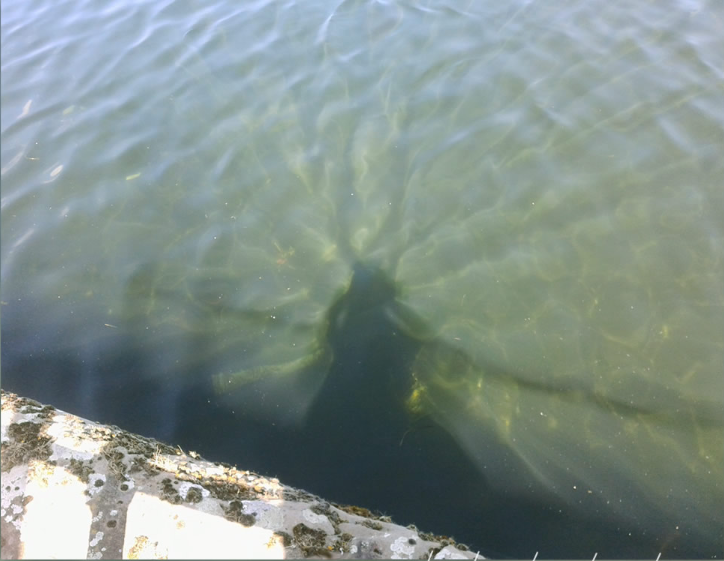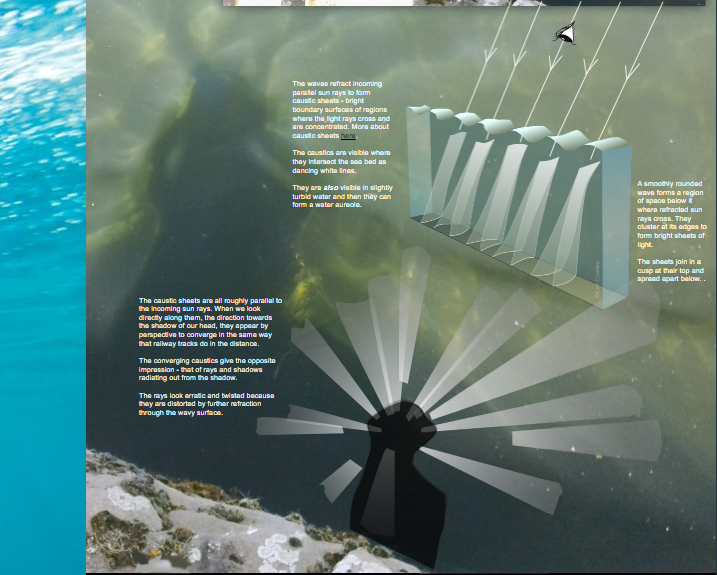OPOD -Water Aureole, Cardiff, Wales
OPOD - Water Aureole, Cardiff, Wales
In the beautiful coastal city of Cardiff, Wales, a fascinating atmospheric phenomenon known as a "water aureole" was captured on camera by Amanda Peters at Atlantic Wharf. This captivating image showcases the interplay between light and water, creating a mesmerizing display of radiating rays and a halo surrounding the shadow of Amanda's head.
The Intricate Dance of Light and Water
Upon closer examination of the photograph, one can observe both dark and light rays seemingly emanating from the shadow. These rays are actually deep within the water, originating from the refracted sunlight. Additionally, on the seabed itself, one can witness the enchanting spectacle of bright dancing caustics. These caustics are the result of the interaction between light and water, forming bright boundary surfaces where light rays intersect and concentrate.
Caustic Sheets and their Formation
The waves on the water's surface play a crucial role in the generation of the water aureole. As incoming parallel sun rays interact with these undulating waves, they undergo refraction, resulting in the formation of caustic sheets. These sheets are visible as dancing white lines where they intersect the seabed or in slightly turbid water. The caustic sheets are generally parallel to the incoming sun rays and, when viewed along their direction, appear to converge similar to railway tracks in the distance.
The Illusion of Radiating Rays and Shadows
The converging caustics create an optical illusion, giving the impression of rays and shadows radiating outwards from the shadow area. These rays may appear erratic and twisted due to further refraction as they pass through the wavy surface of the water. The smoothly rounded shape of a wave creates a distinct region below it where refracted sun rays cross. At the edges of this region, the rays cluster together, forming bright sheets of light. These sheets then join in a cusp at their top and spread apart below, adding to the intricate play of light and water.
The Role of Turbidity in Water Aureole Formation
Interestingly, the presence of slight turbidity in the water can enhance the formation of a water aureole. Turbidity refers to the cloudiness or haziness caused by suspended particles in the water. When these particles interact with the refracted sunlight, they contribute to the scattering and concentration of light, intensifying the effect of the caustic sheets. This phenomenon adds an extra layer of complexity and beauty to the water aureole.
Appreciating Nature's Optical Masterpieces
The captivating image captured by Amanda Peters serves as a reminder of the incredible beauty and complexity present in our natural world. By observing and understanding atmospheric optics phenomena like the water aureole, we gain a deeper appreciation for the interplay between light, water, and our surroundings. These optical masterpieces provide us with moments of awe and wonder, reminding us of the intricate and fascinating nature of our environment.
Conclusion
The water aureole witnessed in Cardiff, Wales, showcases the intricate dance between light and water. Through refraction and the formation of caustic sheets, the rays and shadows appear to radiate from the shadow area. The presence of slight turbidity further enhances this captivating phenomenon. Observing and understanding atmospheric optics phenomena allows us to appreciate the beauty and complexity of nature's creations. So next time you find yourself near a body of water, take a moment to look closely and witness the enchanting interplay between light and water that surrounds us.

Water Aureole
Captured on a 'phone by Amanda Peters at Atlantic Wharf in Cardiff, Wales.
Light and dark rays appear to radiate outwards from the shadow of Amanda's head. It is also surrounded by a lighter halo. A "water aureole".
The dark and light rays are deep in the water.
Deeper still on the seabed itself we see bright dancing caustics.
Away from the shadow area the water surface reflects the sky to reveal gently undulating waves, the key to the aureole generation.
©Amanda Peters

The waves refract incoming parallel sun rays to form caustic sheets - bright boundary surfaces of regions where the light rays cross and are concentrated. More about caustic sheets here.
The caustics are visible where they intersect the sea bed as dancing white lines.
They are also visible in slightly turbid water and then they can form a water aureole.
The caustic sheets are all roughly parallel to the incoming sun rays. When we look directly along them, the direction towards the shadow of our head, they appear by perspective to converge in the same way that railway tracks do in the distance.
The converging caustics give the opposite impression - that of rays and shadows radiating out from the shadow.
The rays look erratic and twisted because they are distorted by further refraction through the wavy surface.
A smoothly rounded wave forms a region of space below it where refracted sun rays cross. They cluster at its edges to form bright sheets of light.
The sheets join in a cusp at their top and spread apart below.
Note: this article has been automatically converted from the old site and may not appear as intended. You can find the original article here.
Reference Atmospheric Optics
If you use any of the definitions, information, or data presented on Atmospheric Optics, please copy the link or reference below to properly credit us as the reference source. Thank you!
-
<a href="https://atoptics.co.uk/blog/opod-water-aureole-cardiff-wales/">OPOD -Water Aureole, Cardiff, Wales</a>
-
"OPOD -Water Aureole, Cardiff, Wales". Atmospheric Optics. Accessed on November 26, 2024. https://atoptics.co.uk/blog/opod-water-aureole-cardiff-wales/.
-
"OPOD -Water Aureole, Cardiff, Wales". Atmospheric Optics, https://atoptics.co.uk/blog/opod-water-aureole-cardiff-wales/. Accessed 26 November, 2024
-
OPOD -Water Aureole, Cardiff, Wales. Atmospheric Optics. Retrieved from https://atoptics.co.uk/blog/opod-water-aureole-cardiff-wales/.